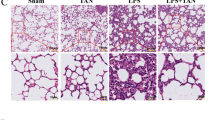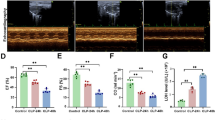Abstract
Background
Lipopolysaccharide decreases intestinal contractility and induces the production of cytokines, which play an important role in the pathogenesis of sepsis.
Aim
The objective of the present study was to examine the role of Toll-like receptor 4, IκB kinase, and the proteasome in the intestinal alterations induced by lipopolysaccharide.
Methods
Sepsis was induced in rabbits by intravenous injection of lipopolysaccharide. Contractility studies of rabbit duodenum were performed in an organ bath. Expressions of interleukin-1β, interleukin-6, interleukin-8, interleukin-10, IκB kinase-α, IκB kinase-β, IκB kinase-γ, and the proteasome mRNA were determined by RT-PCR on rabbit duodenum.
Results
Neomycin and polymyxin B (Toll-like receptor 4 inhibitors), IKK NBD peptide (IκB kinase complex inhibitor), and MG-132 (proteasome inhibitor) blocked partially the effects of lipopolysaccharide on the acetylcholine-, prostaglandin E2-, substance P-, and KCl-induced contractions in the longitudinal and circular smooth muscle of rabbit duodenum. Lipopolysaccharide increased the mRNA expression of interleukin-6 and interleukin-8 in duodenal tissue, and this effect was partly reversed by neomycin, polymyxin B, IKK NBD peptide, and MG-132. IκB kinase-α, IκB kinase-β, IκB kinase-γ, and the proteasome mRNA expressions was not affected by lipopolysaccharide treatment.
Conclusions
Toll-like receptor 4, the IκB kinase complex, and the proteasome could be therapeutic targets in the treatment of sepsis symptoms in the intestine.



Similar content being viewed by others
References
An G, Namas RA, Vodovotz Y. Sepsis: from pattern to mechanism and back. Crit Rev Biomed Eng. 2012;40:341–351.
Parrillo JE. Pathogenetic mechanisms of septic shock. N Engl J Med. 1993;328:1471–1477.
Gonzalo S, Grasa L, Hernandez LV, Arruebo MP, Plaza MA, Murillo MD. Mitogen activated protein kinases blockade improves lipopolysaccharide-induced ileal motor disturbances. Rev Esp Enferm Dig. 2012;104:305–309.
Gonzalo S, Grasa L, Arruebo MP, Plaza MA, Murillo MD. Inhibition of p38 MAPK improves intestinal disturbances and oxidative stress induced in a rabbit endotoxemia model Neurogastroenterol Motil. 2010;22:564–572, e123.
Hernandez LV, Gonzalo S, Castro M, et al. Nuclear factor kappaB is a key transcription factor in the duodenal contractility alterations induced by lipopolysaccharide. Exp Physiol. 2011;96:1151–1162.
Eskandari MK, Kalff JC, Billiar TR, Lee KK, Bauer AJ. LPS-induced muscularis macrophage nitric oxide suppresses rat jejunal circular muscle activity. Am J Physiol. 1999;277:G478–G486.
Lodato RF, Khan AR, Zembowicz MJ, et al. Roles of IL-1 and TNF in the decreased ileal muscle contractility induced by lipopolysaccharide. Am J Physiol. 1999;276:G1356–G1362.
Salinthone S, Singer CA, Gerthoffer WT. Inflammatory gene expression by human colonic smooth muscle cells. Am J Physiol Gastrointest Liver Physiol. 2004;287:G627–G637.
Duncan M, Mouihate A, Mackie K, et al. Cannabinoid CB2 receptors in the enteric nervous system modulate gastrointestinal contractility in lipopolysaccharide-treated rats. Am J Physiol Gastrointest Liver Physiol. 2008;295:G78–G87.
Tsuchiya Y, Nozu T, Kumei S, Ohhira M, Okumura T. IL-1 receptor antagonist blocks the lipopolysaccharide-induced inhibition of gastric motility in freely moving conscious rats. Dig Dis Sci. 2012;57:2555–2561.
Beyaert R, Cuenda A, Vanden Berghe W, et al. The p38/RK mitogen-activated protein kinase pathway regulates interleukin-6 synthesis response to tumor necrosis factor. EMBO J. 1996;15:1914–1923.
Gonzalo S, Grasa L, Arruebo MP, Plaza MA, Murillo MD. Lipopolysaccharide-induced intestinal motility disturbances are mediated by c-Jun NH2-terminal kinases. Dig Liver Dis. 2011;43:277–285.
Gonzalo S, Grasa L, Arruebo MP, Plaza MA, Murillo MD. Extracellular signal-regulated kinase (ERK) is involved in LPS-induced disturbances in intestinal motility. Neurogastroenterol Motil. 2011;23:e80–e90.
Gonzalo S, Grasa L, Fagundes DS, Arruebo MP, Plaza MA, Murillo MD. Intestinal effects of lipopolysaccharide in rabbit are mediated by cyclooxygenase-2 through p38 mitogen activated protein kinase. Eur J Pharmacol. 2010;648:171–178.
Shifera AS. The zinc finger domain of IKKgamma (NEMO) protein in health and disease. J Cell Mol Med. 2010;14:2404–2414.
Qureshi N, Perera PY, Shen J, et al. The proteasome as a lipopolysaccharide-binding protein in macrophages: differential effects of proteasome inhibition on lipopolysaccharide-induced signaling events. J Immunol. 2003;171:1515–1525.
Shen J, Reis J, Morrison DC, et al. Key inflammatory signaling pathways are regulated by the proteasome. Shock. 2006;25:472–484.
Dai S, Hirayama T, Abbas S, Abu-Amer Y. The IkappaB kinase (IKK) inhibitor, NEMO-binding domain peptide, blocks osteoclastogenesis and bone erosion in inflammatory arthritis. J Biol Chem. 2004;279:37219–37222.
Barona I, Fagundes DS, Gonzalo S, et al. Role of TLR4 and MAPK in the local effect of LPS on intestinal contractility. J Pharm Pharmacol. 2011;63:657–662.
Levey AI. Immunological localization of m1–m5 muscarinic acetylcholine receptors in peripheral tissues and brain. Life Sci. 1993;52:441–448.
Jadcherla SR. Inflammation inhibits muscarinic signaling in in vivo canine colonic circular smooth muscle cells. Pediatr Res.. 2002;52:756–762.
Zhou H, Liang H, Li ZF, Xiang H, Liu W, Li JG. Vagus nerve stimulation attenuates intestinal epithelial tight junctions disruption in endotoxemic mice through alpha7 nicotinic acetylcholine receptors. Shock. 2013;40:144–151.
Holzer P, Holzer-Petsche U. Tachykinins in the gut. Part I. Expression, release and motor function. Pharmacol Ther. 1997;73:173–217.
Valero MS, Fagundes DS, Grasa L, Arruebo MP, Plaza MA, Murillo MD. Contractile effect of tachykinins on rabbit small intestine. Acta Pharmacol Sin. 2011;32:487–494.
Al-Saffar A, Hellstrom PM. Contractile responses to natural tachykinins and selective tachykinin analogs in normal and inflamed ileal and colonic muscle. Scand J Gastroenterol. 2001;36:485–493.
Grasa L, Arruebo MP, Plaza MA, Murillo MD. PGE(2) receptors and their intracellular mechanisms in rabbit small intestine. Prostaglandins Other Lipid Mediat. 2006;79:206–217.
Akira S, Uematsu S, Takeuchi O. Pathogen recognition and innate immunity. Cell. 2006;124:783–801.
Cohen J. The immunopathogenesis of sepsis. Nature. 2002;420:885–891.
Dinarello CA. The IL-1 family and inflammatory diseases. Clin Exp Rheumatol. 2002;20:S1–S13.
Swinney DC, Xu YZ, Scarafia LE, et al. A small molecule ubiquitination inhibitor blocks NF-kappa B-dependent cytokine expression in cells and rats. J Biol Chem.. 2002;277:23573–23581.
Rumio C, Besusso D, Arnaboldi F, et al. Activation of smooth muscle and myenteric plexus cells of jejunum via Toll-like receptor 4. J Cell Physiol. 2006;208:47–54.
Bazzoni F, Tamassia N, Rossato M, Cassatella MA. Understanding the molecular mechanisms of the multifaceted IL-10-mediated anti-inflammatory response: lessons from neutrophils. Eur J Immunol. 2010;40:2360–2368.
Cassatella MA, Meda L, Bonora S, Ceska M, Constantin G. Interleukin 10 (IL-10) inhibits the release of proinflammatory cytokines from human polymorphonuclear leukocytes. Evidence for an autocrine role of tumor necrosis factor and IL-1 beta in mediating the production of IL-8 triggered by lipopolysaccharide. J Exp Med. 1993;178:2207–2211.
Saito M, Payne MS, Miura Y, et al. Polymyxin B agonist capture therapy for intrauterine inflammation: proof-of-principle in a fetal ovine model. Reprod Sci. 2014;21(5):623–631.
Park HG, Bak EJ, Kim JH, et al. Effect of globular adiponectin on interleukin-6 and interleukin-8 expression in periodontal ligament and gingival fibroblasts. J Periodontal Implant Sci. 2011;41:149–156.
May MJ, D’Acquisto F, Madge LA, Glockner J, Pober JS, Ghosh S. Selective inhibition of NF-kappaB activation by a peptide that blocks the interaction of NEMO with the IkappaB kinase complex. Science. 2000;289:1550–1554.
Nenci A, Becker C, Wullaert A, et al. Epithelial NEMO links innate immunity to chronic intestinal inflammation. Nature. 2007;446:557–561.
von Bismarck P, Winoto-Morbach S, Herzberg M, et al. IKK NBD peptide inhibits LPS induced pulmonary inflammation and alters sphingolipid metabolism in a murine model. Pulm Pharmacol Ther. 2012;25:228–235.
Chen FT, Liu YC, Yang CM, Yang CH. Anti-inflammatory effect of the proteasome inhibitor bortezomib on endotoxin-induced uveitis in rats. Invest Ophthalmol Vis Sci. 2012;53:3682–3694.
Chatterjee PK, Yeboah MM, Dowling O, et al. Nicotinic acetylcholine receptor agonists attenuate septic acute kidney injury in mice by suppressing inflammation and proteasome activity. PLoS One. 2012;7:e35361.
Bozinovski S, Seow HJ, Crack PJ, Anderson GP, Vlahos R. Glutathione peroxidase-1 primes pro-inflammatory cytokine production after LPS challenge in vivo. PLoS One. 2012;7:e33172.
Acknowledgments
This work was funded by Gobierno de Aragón (B61/2013), Spain.
Conflict of interest
None.
Author information
Authors and Affiliations
Corresponding author
Rights and permissions
About this article
Cite this article
Gonzalo, S., Valero, M.S., Martínez de Salinas, F. et al. Roles of Toll-Like Receptor 4, IκB Kinase, and the Proteasome in the Intestinal Alterations Caused by Sepsis. Dig Dis Sci 60, 1223–1231 (2015). https://doi.org/10.1007/s10620-014-3418-6
Received:
Accepted:
Published:
Issue Date:
DOI: https://doi.org/10.1007/s10620-014-3418-6




